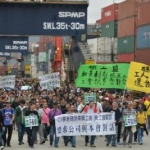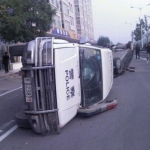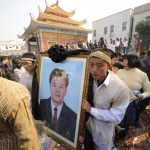Articles in the Contemporary China Category
Headline, Ongoing Struggles, Workers »

Some international supporters of both the striking HK dock workers and the struggles against tar sands development in North America have set up a website to coordinate international solidarity actions and translate information about the strike. The following are (1) a brief overview of the stike, and (2) an explanation of the link to tar sands development they prepared for Earth Day (today). “As we think about the Tar Sands and fight the exploitation of native lands for a few people’s profits, remember Li Ka-Shing, who is one of those few, and the Hong Kong dock workers who also refuse to be exploited for his profit.” “Li Ka-Shing, the world’s 8th richest human being and the man who controls the Hong Kong docks, is not only the man Hong Kong’s dockworkers are fighting — he is also one of the people our anti-tar sand friends in North America need to be targeting…”
Husunzi, Ongoing Struggles, Workers »

“Five hundred dockworkers are facing down the richest man in Hong Kong (and, according to Forbes, eighth-richest in the world) in a strike that has entered its third week and brought transport in the world’s third-busiest port to a virtual halt. Li Ka-shing, the billionaire behind Hongkong International Terminals (HIT), controls more than 70 percent of Hong Kong’s port container traffic and oversees a vast transnational network of enterprises including the oil and gas giant Husky. Arrayed against this financial titan often referred to as “Superman” are dockworkers exhausted by 12-hours shifts lacking even toilet breaks, surviving in one of the world’s most expensive cities on wages that haven’t risen in 15 years, and now waging a labor battle that observers are calling pivotal. The confrontation appears to have tapped a vein of indignation against the “greed economy” and its glaring inequalities, bringing the workers broad public support…” (Two reports on the strike.)
Contemporary China, Workers »

In spring 2010, workers at a Honda plant in the industrial city of Foshan, Guangdong went on strike… This conflict triggered a strike wave across several industries and regions that lasted about two months. In autumn 2011, the inhabitants of Wukan, Guangdong took control of their rural town and kicked out local party and government staff….
These are prominent examples of the success and failure of the Chinese government’s counterinsurgency policies. Social unrest has been increasing since the mid-1990s, involving all three dangerous classes – peasants, urban workers, and migrant workers. Land conflicts, strikes, and riots in the countryside as well as the cities could be harbingers of an explosion of struggles that might blow up the existing socioeconomic power structures. However, the counterinsurgency policies were successful because the explosion has not yet taken place, despite the tension and frictions. Social unrest has put immense pressure on the regime but has not loosened its grip on power. The new ruling class of old Party officials and their Capitalist offspring1 and allies have not only modernized and strengthened the anti-uprising apparatus, but also created a range of institutions to mediate, pacify, and integrate social conflicts.
Contemporary China, Ongoing Struggles, Rural China »

Reposted from Rekolektiv:
Reports from Wukan, Guangdong, the Chinese village in revolt against local government have generated more shocked gasps from the Anglophone media than in-depth reporting, resulting in a general paucity of information, let alone insightful analysis. But thanks to a 52-minute homemade video about the protest and one other report online at iSun Affairs we’re getting a little more detail. The following is a rudimentary translation of the timeline of events provided at the iSun report. I welcome any advice on the translation:

